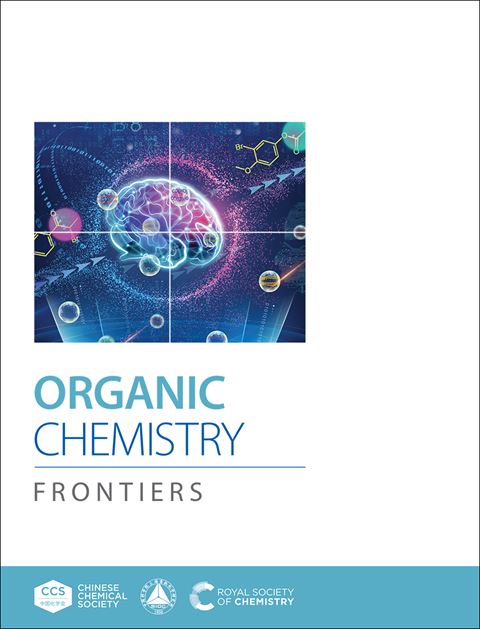Сross-dehydrogenative C-O coupling of oximes with hydrazones: synthesis of fungicidal azo oxime ethers
IF 4.7
1区 化学
Q1 CHEMISTRY, ORGANIC
引用次数: 0
Abstract
The cross-dehydrogenative coupling (CDC) of oximes with hydrazones employing KMnO 4 as the oxidant was discovered.Presumably, the reaction proceeds through the selective cross-recombination of oxime and hydrazone-derived free radicals despite the fact that both of them are known to undergo self-coupling and other processes with C-C, C-O, C-N, and N-N bond formation. The proposed approach is general and applicable to a broad range of oximes and hydrazones. Previously, oxime derived radicals were mainly involved in intramolecular processes of C-O bond formation, while intermolecular processes remained rare and their scope was limited. On the other hand, radical functionalization of hydrazones was generally limited to radical addition and hydrogen substitution reactions of aldehyde hydrazones. The formation of azo compounds in the present work represents a distinctive direction for further development. The synthesized compounds exhibited pronounced fungicidal activity against a wide spectrum of phytopathogenic fungi (Venturia inaequalis, Rhizoctonia solani, Fusarium oxysporum, Fusarium moniliforme, Bipolaris sorokiniana, Sclerotinia sclerotiorum) in some cases surpassing the activity of commercial fungicides triadimefon, krezoxim-methyl, and azoxystrobin. Key factors contributing to the high fungicidal activity were identified as the presence of a small aliphatic substituent at the C-O coupling site and electronwithdrawing substituents in the oxime moiety.Сross-dehydrogenative氧肟与腙的C-O偶联:杀真菌偶氮氧肟醚的合成
发现了以kmno4为氧化剂的肟类化合物与腙类化合物的交叉脱氢偶联反应。据推测,该反应是通过肟基和腙基自由基的选择性交叉重组进行的,尽管已知这两种自由基都经历了自偶联等与C-C、C-O、C-N和N-N成键的过程。所提出的方法是通用的,适用于广泛的肟类和腙类。在此之前,肟类自由基主要参与C-O键形成的分子内过程,而分子间过程较少且范围有限。另一方面,自由基官能化一般局限于醛腙的自由基加成和氢取代反应。偶氮化合物的形成为今后的发展提供了一个独特的方向。合成的化合物对广泛的植物病原真菌(Venturia inaequalis, Rhizoctonia solani, Fusarium oxysporum, Fusarium moniliformme, Bipolaris sorokiniana, sclerotiorum)具有明显的杀真菌活性,在某些情况下超过了商业杀菌剂triadimeon, krezoximm -methyl和azoxystrobin的活性。导致高杀真菌活性的关键因素是在C-O偶联位点存在一个小的脂肪取代基和在肟部分存在吸电子取代基。
本文章由计算机程序翻译,如有差异,请以英文原文为准。
求助全文
约1分钟内获得全文
求助全文
来源期刊

Organic Chemistry Frontiers
CHEMISTRY, ORGANIC-
CiteScore
7.90
自引率
11.10%
发文量
686
审稿时长
1 months
期刊介绍:
Organic Chemistry Frontiers is an esteemed journal that publishes high-quality research across the field of organic chemistry. It places a significant emphasis on studies that contribute substantially to the field by introducing new or significantly improved protocols and methodologies. The journal covers a wide array of topics which include, but are not limited to, organic synthesis, the development of synthetic methodologies, catalysis, natural products, functional organic materials, supramolecular and macromolecular chemistry, as well as physical and computational organic chemistry.
 求助内容:
求助内容: 应助结果提醒方式:
应助结果提醒方式:


